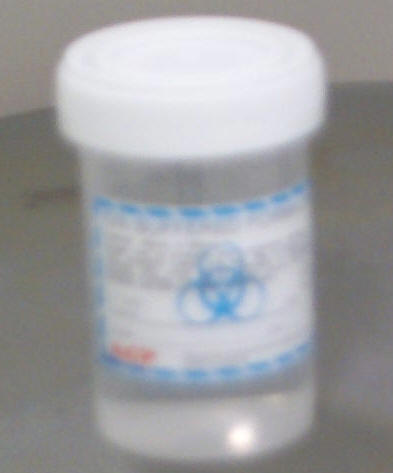| Collection Information | Specimen should be collected in the operating
room, ambulatory care or in a physicians office. I.1. All specimens must
be accompanied by a completed Surgical Pathology Card (form PATH_6707_0103).
The following information is required on the card, clearly written in ink:
(a) Patient identifiers
(i) patient's first and last name
(ii) unique number
(iii) date of birth
(iv) Ontario Health Insurance Number with version code.
(b) Submitting area identifiers: Hospital site (BGH or The Willett) and the
submitting department (Emergency, Ambulatory Care etc.).
(c) Submitting physician's name.
(d) Date of surgery
(e) Pre- and post-operative presumptive diagnosis.
(f) A brief clinical history.
(g) Specimen information
(i) tissue type (ie. Breast)
(ii) anatomical site (ie. Right side)
(iii) surgical procedure (ie. wire localization biopsy)
I.2. The specimen container must be labeled. Addressograph labels are
preferred, otherwise the following information must be provided, clearly
written in ink:
(a) Patient identifiers
(i) patient's full name
(ii) unique number
(iii) and at least one other unique additional identifier (ie. date of
birth, OHIN).
(b) Date of surgery.
(c) Specimen name, anatomic site and surgical procedure, as it is written on
the Surgical Pathology card.
This information must be recorded on the side of the specimen container and
not the lid.
If a specimen is known or suspected to contain unique or extreme biohazard
(e.g. CJD) the container shall be so marked.
I.3. Routine surgical specimens must be placed in 10% Neutral Buffered
Formalin (10%NBF) for fixation. Specimens must be placed in an appropriate
sized container with an amount of formalin equal to or greater than fifteen times the volume of tissue.
I.4. Place smaller specimen containers in a biohazard bag. The surgical
card should be placed in the outer pouch of the biohazard bag.
Larger specimen containers, with their Surgical Pathology cards, should be
transported in a manner that would facilitate spill containment should the
container open during transport.
I.5. Transport the specimen containers to the Grossing Room in the Department
of Anatomical Pathology.
I.6. Inform histology staff that you have delivered a specimen or
specimens.
I.7. After hours: Fresh specimens should be delivered to the Lab triage
area, where they will be refrigerated until processed by
Pathology staff. Specimens in NBF can be delivered to the triage area or
held by the submitting department at room temperature until day staff
responsible for specimen delivery arrives. |
|---|








